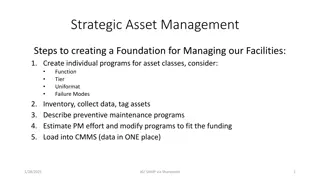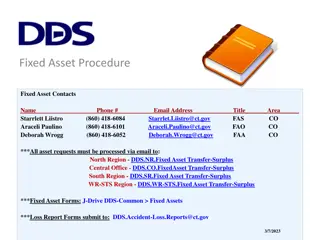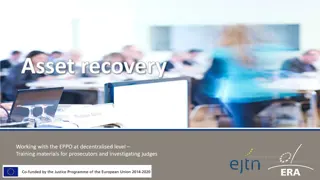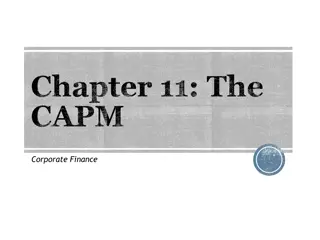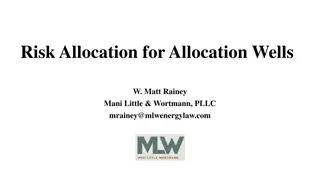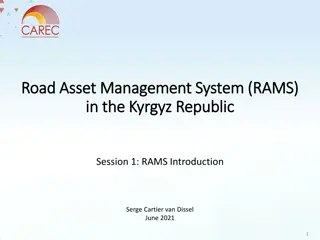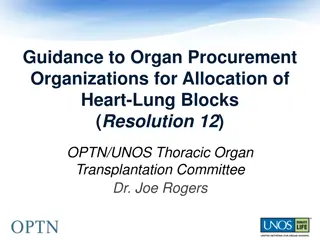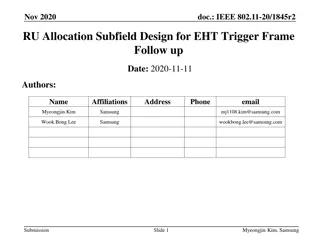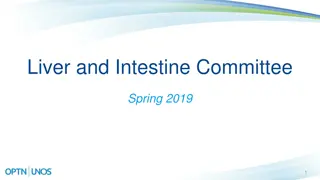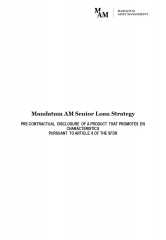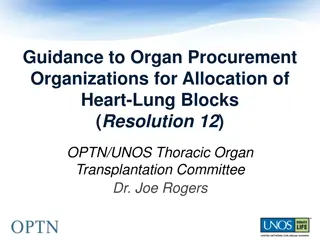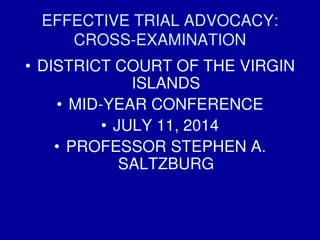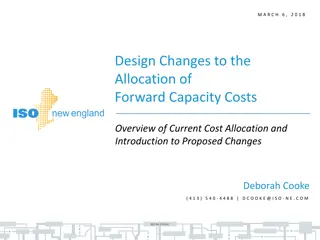Enhancing Investment Strategies Through Cross Asset Allocation
Cross Asset Allocation is a decision-making process that optimizes the distribution of limited funds across various programs to achieve organizational objectives. In this project, the KYTC aims to improve its investment strategy by breaking silos and prioritizing investments based on impact assessments, trade-off analyses, and performance metric evaluations. By considering factors such as agency constraints and stakeholder priorities, the project seeks to enhance overall portfolio performance and benefit prediction.
Download Presentation

Please find below an Image/Link to download the presentation.
The content on the website is provided AS IS for your information and personal use only. It may not be sold, licensed, or shared on other websites without obtaining consent from the author. Download presentation by click this link. If you encounter any issues during the download, it is possible that the publisher has removed the file from their server.
E N D
Presentation Transcript
An Introduction to Cross Asset Allocation A KYTC Continuous Improvement Project Amanda Spencer Maridely Loyselle Jake Rice
Conception We had a phenomenal idea that we were excited about and ready to run with, then We asked John Moore to be our sponsor You make plans, and John Moore laughs Upon securing John as our sponsor, he strongly suggested we pursue this project After some initial research and picking John s brain, we quickly saw the high value and potential this project can have!
Overview What is Cross Asset Allocation? A decision making process used to effectively disperse limited funds and resources across multiple programs in a way that maximizes performance in line with organizational goals. Why is it needed? To improve KYTC s investment strategy by redirecting our thinking outside of our silos Limited Funds Safety Asset Mgmt Congestion Mobility
Framework Decision Methodology: Project Impact Assessment: Trade-off Analysis: Goals and Objectives: Performance Metric Evaluation: Q: How can we minimize impact given financial constraints & agency/stakeholder priorities? Q: How can we compare and rank dissimilar projects across investment areas? Q: How can we assess investment impacts prior to implementation? Q: How can we better serve our stakeholders in the future? Q: How can we best predict and monitor progress towards goals? A: Predict A: Optimize project portfolio per agency preferences and constraints. performance impacts of proposed projects; forecast benefits & tradeoff. A: Make our goals clear and our process directional and specific. A: Select performance measures that align to goals & objectives. A: Conduct scenario analysis to evaluate possible outcomes.
Considerations Considerations when determining investments across programs What s the right investment strategy for a given program? How does each program contribute to KYTC s goals? How does each program determine project schedules and importance? How does KYTC prioritize investments across assets and investment areas given funding limitations? The typical investment strategy of the past and present entails working in silos How can we improve our investment strategy? How can we start operating outside of our silos?
Historical Practices of Allocation Allocations have been based on: Let s do this because it s what we ve always done Formula-driven based performance measures State-wide programs: Regions submit rank-ordered project lists Central Office validates and uses manual-driven processes to finalize project selection based on equity and funding eligibility Trends are showing: States are moving towards performance-based principles, but focus more on reporting than predicting Increased legislative pressure demands transparency
Application of Cross-Asset Investments Basic Approach Determine how to integrate KYTC s goals and objectives Calculate and assign values to individual potential projects and they move the needle Prioritize and consider the value of each project and it s costs Benefits More efficient and effective use of funds Improved systematic performance Improved transparency Improved confidence of decisions Improved reliability of the process
Application Challenges Defining the scope of analysis Projects often end up being prioritized within a selected set of investment categories for a single decision period Developing a set of candidate programs Defining the utility function Can be difficult to quantify goals and objectives Weighting objectives The Analytical Hierarchy Process (AHP) is often used to establish weights through a set of comparisons A Data Envelopment Analysis (DEA) procedure can circumvent the need for additional steps
The Framework In-Depth
Step 1: Establish the Scope What are the programs to allocate funding to? What are the assets of each program? What do the investments in each program entail? What is the decision timeframe? How does the approach fit into the existing procedures of annual business? How will the results be used and who will they be shared with?
Step 2: Define Goals and Objectives Goals should be a reflection of the Cabinet s mission. They should not repeat or overlap. They should incorporate strategic plans and agreements. Goals should be realistically limited to between 5 and 7 total. They should convey a clear intent. Important aspects to pay attention to include: accessibility, mobility, community impact, environmental impact, economic development, preservation, and safety.
Step 3: Select Performance Measures and Evaluation Criteria Chosen performance measures need to quantify progress towards goals and objectives . They should ensure compliance with requirements. A common unit of measurement needs to be established. Each objective should have between 1 and 3 specific attributes. The attributes need to be able to be measured quantitatively and easy to understand. Must also consider scale ratios based on project size.
Step 4: Assess Data and Analytical Capabilities Ensure the data needed to support analyses and performance measures is possessed. Explore data that can be obtained from existing databases. Examine possible approaches for addressing challenges with existing datasets, such as gaps or incompleteness. Aim to forecast developmental requirements.
Additional Steps Set weights on goals and objectives. Test your predictions and run the numbers. Communicate the results: Identify key outcomes and provide explanations of their impacts on goals and objectives. Make them available on an easily accessible platform. Provide clarification of why funding decisions may differ from initial priorities.
Cross Asset Allocation for KYTC How it will look: If there were one more dollar, where should it go? Put project value above historic programmatic allocation. Allow performance to drive project selection. Select the next best project that optimizes resources while considering project schedules, dependencies, and constraints. Make the case for increased funding flexibility. Understanding the trade-off Should I invest more or less in a particular region? Should I shift money from one asset to another? What if I was not authorized to allocate this way? What if priorities change? Which targets do I need to aim to achieve.?
Collaboration with KYTCs finest Mike Vaughn of HSIP Tracy Nowacyzk of Maintenance Joe Thompson, Nathan Ridgway, and Ted Swansegar of HSIP Signals Jason Siwula of SHE s Office and Safety
HSIP They attempt to evaluate the effectiveness of their projects on annual basis and report their findings to FHWA. The bulk of their funding is based on prioritizing EEC values. Crash data is their number one criteria for decision making. Aim to incorporate EEC data in SHIFT. If 20% additional funds were available to allocate, they would invest in it addressing roadway departure crashes. Reactive rather than proactive due to lack of district staff.
HSIP (Signals?) KTC performs a screening process helps determine funding allocation; 45% dedicated to roadway departure crashes. Each district greatly differs in crash performance Locations for safety improvements determined by screening process. Needs change over time; e.g. cable barrier had a high return on investment 5 years ago, but now high friction surfaces provide a higher return on investment. Signal optimization projects are evaluated every 3 5 years. Trying to utilize Waze and HERE livestream data for accidents to effectively reroute traffic to help reduce congestion around the accident site.
Maintenance Preservation of pavement and bridge assets are priority. Most developed assets: pavements, bridges, and guardrail. Developed scenarios how funds can allocated utilizing investment effectiveness measures such as the Pavement Sustainability Ratio (PSR). The key aspect of allocation is a common index that is measurable across all programs. Biggest challenge is determining average costs for projects.
Safety Data driven program, most of their data comes from KY Ops, HIS, and KSP. Beginning to use more autonomous vehicle data as well. Data evaluation determines problematic areas to address. Looking to increase mobility for medical care access in rural areas. Aiming to have increased education programs and advertising campaigns. Frequent coordination with state and local police agencies. Funding sources: road fund & NHTSA. Their ultimate goal is to have under 500 roadway fatalities by 2024. If 20% additional funds were available to allocate, they would invest more rural medical service accessibility.
What are other States doing? Other states have attempted to develop a Cross Asset Allocation decision making process, but none have perfected it yet. Front runner states include: Minnesota, Washington, Iowa, Florida, Virginia, Oregon, and Utah.
Lessons learned by other DOTs Two main hurdles encountered by other DOT s 1) Program/asset selection 2) Obtaining required data Most strategies are data dependent Various systems are available for supporting a cross asset allocation approach, most notably the prototype tool provided with NCHRP Report 806 Most programs are still in a testing/experimental phase, far from implementation
Implementation Steps 1. Establish a sub-program 2. Use the long range or strategic plan to assist with guiding goals and objectives 3. Incorporate asset management data at the project level 4. Build-in considerations for must do and political projects as well as any sub-area equity concerns
Value at KYTC Upon implementation of Cross Asset Allocation, there will be many added values, including but not limited to: Ability to optimize investments Improved decision-making and transparency to build public trust Better informed investment decisions A higher overall benefit/cost ratio Optimized Investments Improved Public Confidence Informed Decisions Higher B/C Ratio




